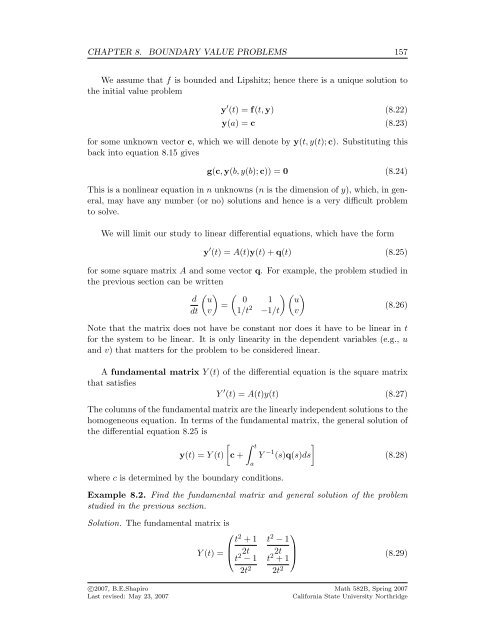The Computable Differential Equation Lecture ... - Bruce E. Shapiro
The Computable Differential Equation Lecture ... - Bruce E. Shapiro
The Computable Differential Equation Lecture ... - Bruce E. Shapiro
You also want an ePaper? Increase the reach of your titles
YUMPU automatically turns print PDFs into web optimized ePapers that Google loves.
CHAPTER 8. BOUNDARY VALUE PROBLEMS 157<br />
We assume that f is bounded and Lipshitz; hence there is a unique solution to<br />
the initial value problem<br />
y ′ (t) = f(t, y) (8.22)<br />
y(a) = c (8.23)<br />
for some unknown vector c, which we will denote by y(t, y(t); c). Substituting this<br />
back into equation 8.15 gives<br />
g(c, y(b, y(b); c)) = 0 (8.24)<br />
This is a nonlinear equation in n unknowns (n is the dimension of y), which, in general,<br />
may have any number (or no) solutions and hence is a very difficult problem<br />
to solve.<br />
We will limit our study to linear differential equations, which have the form<br />
y ′ (t) = A(t)y(t) + q(t) (8.25)<br />
for some square matrix A and some vector q. For example, the problem studied in<br />
the previous section can be written<br />
( ) ( ( )<br />
d u 0 1 u<br />
=<br />
dt v 1/t −1/t) 2 (8.26)<br />
v<br />
Note that the matrix does not have be constant nor does it have to be linear in t<br />
for the system to be linear. It is only linearity in the dependent variables (e.g., u<br />
and v) that matters for the problem to be considered linear.<br />
A fundamental matrix Y (t) of the differential equation is the square matrix<br />
that satisfies<br />
Y ′ (t) = A(t)y(t) (8.27)<br />
<strong>The</strong> columns of the fundamental matrix are the linearly independent solutions to the<br />
homogeneous equation. In terms of the fundamental matrix, the general solution of<br />
the differential equation 8.25 is<br />
y(t) = Y (t)<br />
[<br />
c +<br />
∫ t<br />
where c is determined by the boundary conditions.<br />
a<br />
]<br />
Y −1 (s)q(s)ds<br />
(8.28)<br />
Example 8.2. Find the fundamental matrix and general solution of the problem<br />
studied in the previous section.<br />
Solution. <strong>The</strong> fundamental matrix is<br />
⎛<br />
t 2 + 1<br />
⎜<br />
Y (t) = ⎝ 2t<br />
t 2 − 1<br />
2t<br />
t 2 − 1 t 2 + 1<br />
2t 2 2t 2<br />
⎞<br />
⎟<br />
⎠ (8.29)<br />
c○2007, B.E.<strong>Shapiro</strong><br />
Last revised: May 23, 2007<br />
Math 582B, Spring 2007<br />
California State University Northridge
















